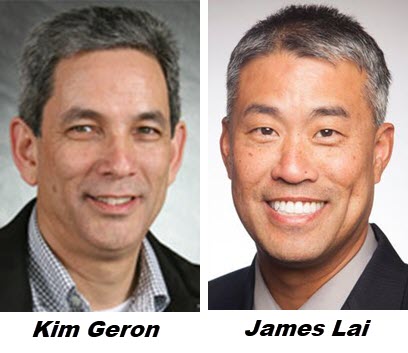excerpted from: Kim Geron and James S. Lai, Beyond Symbolic Representation: A Comparison of the Electoral Pathways and Policy Priorities of Asian American and Latino Elected Officials, 9 Asian Law Journal 41- 81, 41-42, 81 (May, 2002) (109 Footnotes) (Full Document)
 This is an exploratory study of the impact of Latino and Asian American elected officials on their respective groups' political incorporation. The authors argue that Latino and Asian American elected officials' paths to elected office do not always fit the biracial coalition model of political incorporation for minorities, and instead suggest a reconstructed model to explain the distinctive character of Latino and Asian American group efforts toward political representation.
This is an exploratory study of the impact of Latino and Asian American elected officials on their respective groups' political incorporation. The authors argue that Latino and Asian American elected officials' paths to elected office do not always fit the biracial coalition model of political incorporation for minorities, and instead suggest a reconstructed model to explain the distinctive character of Latino and Asian American group efforts toward political representation.
The results of this paper are based on information gathered from two nationwide mail surveys of Latino elected officials and Asian American elected officials. The 2000 National Asian American and Latino Elected Officials Survey was conducted in Fall 2000 with interviews of elected officials held in 2001. The 1999 National Asian American Elected Officials Survey was conducted in May 1999 with interviews of elected officials held throughout 2000. This paper focuses on analyzing the means by which Latinos and Asian Americans have achieved political power, their sources of community support, and the resources they needed to succesfully win office. It also examines current Latina/o and Asian American office- holders and explores whether they direct policy benefits to their respective communities.
The results of these surveys indicate that Latino and Asian American politicians are on average older, more financially secure, and better educated than their respective general populations. They also are more liberal ideologically than the general populations. The analysis further reveals that the percentage of ethnic population is a stronger determinant for the election of Latino politicians than for Asian American politicians. A significant number of Latino elected officials aim their policies to benefit primarily the Latino community, whereas Asian American elected officials focus on broader community isues due to their districts' demographics. Ethnicity, however, can play a significant role for Asian American elected officials, particularly in raising campaign contributions from their communities. This paper concludes that despite internal heterogeneity and structural barriers that have limited both groups' political advancement, Latino and Asian American political activists are using a variety of methods to achieve political incorporation and policy responsiveness at the local and state levels.
. . .
This exploratory research into the electoral efforts and policy priorities of a new cohort of ethnic elected officials finds that they have both drawn on ethnic support to achieve elected office. A significant number of Asian American elected officials have relied on outside pan-ethnic funding support to compensate for limited voting power in their non-Asian districts. Latino elected officials, on the other hand, have relied on family and friends, combined with selective interest support, including unions and business interests, to achieve electoral office. Their policy priorities reflect their similar immigrant origins and liberal backgrounds. This paper represents the beginning of ongoing research on historically understudied groups of elected officials. Future research is needed to explore the levels of political incorporation for Latino elected officials and Asian American elected officials and to measure the extent of incorporation in different locations and under different circumstances. Whether Latino elected officials and Asian American elected officials can become part of the governing coalitions in urban cities beyond the level of formal representation remains to be seen. Also, more research is needed to explore the impact of Latino and Asian Pacific American political incorporation on the political fortunes of African Americans, as all these groups increasingly find themselves pitted against each other for electoral positions in areas where they are concentrated. Furthermore, the growth of political participation of other people of color such as Caribbean Island immigrants, Native Americans, and people of mixed race backgrounds will create new areas of research into the different pathways of political incorporation.
In a society as diverse as the United States, equality for all remains an elusive goal. In a nation where the dominant majority has used physical and cultural differences to discriminate and to marginalize minority groups, the need for symbolic and substantive representation is a necessary step in a much longer process of full equality for historically underrepresented groups. The political representation of minority groups is exclusively the responsibility of its members. However, the historical divisions amongst the racialized peoples of this country require continued exploration of how minority representatives act to represent their own historically underrepresented group members and others in a similar situation. As Williams notes, "Although representation for marginalized groups is not in itself a cure for injustice, there is good reason to believe it is at least a healing measure."
Kim Geron is Assistant Professor, Department of Political Science, California State University, Hayward.
James S. Lai is Assistant Professor, Department of Political Science and Ethnic Studies Program, Santa Clara University.


